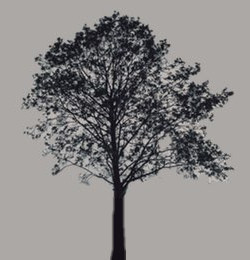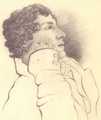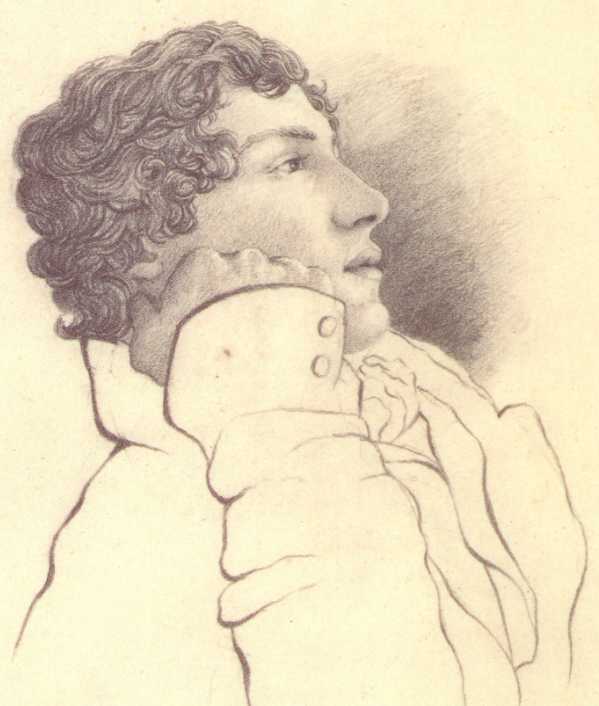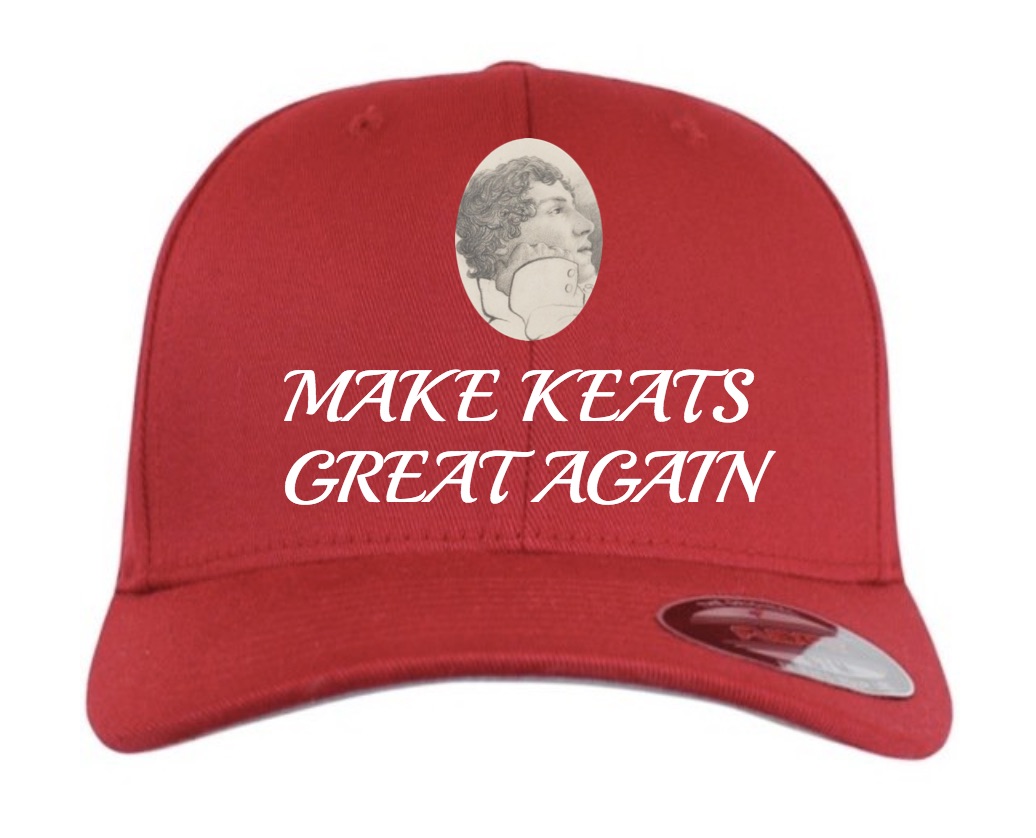


As an image, idea, and icon, “John Keats” appears just about everywhere beyond, and generally sprung from, the depictions by Joseph Severn, Benjamin Robert Haydon, and William Hilton—though I tend to favor the 1819 sketch by his very close and generous friend Charles Armitage Brown, since (for me) it captures the look and facial demeanor of a young, intelligent, and handsome young man, one at ease and natural, despite the bare-bone nature of the sketch. (Brown’s sketch—pictured here—is from the National Portrait Gallery, London--click to enlarge)
Evolving from these canonical depictions are most of the variations in collections and selections of Keats’s work, as well as in magazines, newspapers, and book covers; and of course there are busts, statues, engravings, woodcuts, stamps, and medallions. But there are also playing cards, posters, and even cigar labels—and now you can have Keats placed on just about anything. There are companies out there that hope that you might, for example, need Keats on a t-shirt, tote bag, apron, plate, mouse pad, memory stick, water bottle, or greeting card. Or how about a MKGA trucker cap? Consider it done:

The selection in the Gallery offers versions of John Keats—or, as
he sometimes called himself, Junkets
—to look at, including a couple of pretty good
tattoos. We could talk endlessly about commodity fetishism, image culture, mimetic
desire, blah
blah blah—but we all get how thi$ work$. In the age of mass production, classical
Keats can be
instantly flipped into Keats kitsch if a buck is to be made, or if some new version
of cute or
cool can be mustered.
When Keats writes that he thinks he shall be among English Poets after my death,
he has
no idea he’d also end up on ties, tiles, and tattoos. The most remarkable thing about
his
quietly brash statement is not that it becomes true, but that, at this point, in October
1818,
he has not written anything that deserved such status—but he seems to know he will,
and, within
a matter of months, he writes poetry that does, rightfully, place him into the greater
anthology
of poetic history. That is, in October 1818, Keats knows exactly what kind of poetic
character
he needs to make manifest in his poetry (see his 27
October letter to Richard Woodhouse); he
just has to write it.
A few words on Keats’s appearance: Some of the more canonical depictions and descriptions
attempt to romanticize our Romantic poet, emphasizing large and vulnerable eyes, and
an
expression that moves between innocence, desire, and dreamy, visionary capabilities.
Other
portrayals render a handsome, healthy, and determined young man, though his very modest
height
(just a bit over five feet) does not feature. (The average height of an English adult
male in
Keats’s time is closer to 5’7”.) Keats was self-conscious of his height, and at one
point he
half jokes that he is “somewhat stunted” (to Marian and Sarah Jeffery, 25 May 1818),
and he
refers to himself through the eyes of some others as “Mister John Keats five feet
high” (to
Benjamin Bailey, 22 July 1818). His attitude and
bearing of course makes him taller. And a few paintings perhaps tend to thin him out
a bit. But
what most acquaintances comment upon in writing is his really good hair—medium brown
to light
auburn, it seems, with some reddish-gold highlights and natural curls; he was said
to have
mainly worn his hair parted down the middle. Many simply noted his wavy hair was
beautiful,
with those silken curls falling into ringlets.
In truth, Keats was no wimp, and, despite some developing health issues in his early
adult life
(first appearing as a chronic sore throat), his activities and interests clearly point
to a
robust physical nature powered by sturdy legs and solid, fairly broad shoulders. Stocky
would be
pushing it; compact might be better; but he seemed to exude a certain physical vibrancy
in his
manner, as more than a few first-hand descriptions note. Our idea of Keats as the
waning, wispy
aesthete comes about in part with the strange Victorian fetish for a consumptive,
evanescent
look, a vulnerable and victimized Keats, and by picturing him in the last year of
his life only,
as he slowly, agonizingly falls to the white plague,
tuberculosis—suffering from a
decline,
as it was sometimes called. We should rather imagine the wining, dining, dancing,
card-playing, theatre-going, museum-cruising, street-strolling, path-wandering, hard-working,
hill-climbing Keats seemed up for just about anything his friends or circumstances
threw his
way. He was hardly the isolated, shrinking aesthete who spent all his time fondling
moss,
babbling with brooks, or locked away with books by waning candle-light. We know he
studied and
composed with concentrated energy, but his social life in extraordinarily vibrant
and varied
Regency London was equally varied and vibrant.
But it is that face and expression that seemed to captivate. His look
seems have been
delicate, animated, and challenging at the same time—almost all who actually knew
or met him
suggest he possessed a manly and determined countenance. His lips and eyes seem most
striking:
his mouth is full and his large, his hazel eyes lustrous, with his friends unable
to conclude if
the sum of his look reflected spirit or acuity—though in truth, probably both. A strong
chin
also contributed to an appearance that many found notable. At least one friend (Leigh Hunt) thought his head was on the small size with
(according to his close friend, the painter Benjamin
Robert Haydon) a lowish forehead,and perhaps wider than average.
Perhaps some word from Brown about Keats’s appearance beyond that wonderful sketch might carry some credibility, since Brown probably spent more time with Keats than any of Keats’s other friends, many of whom were, after Keats’s death, clamoring and infighting about who might be best fit to write the first biography of Keats. According to Brown:
He was small in stature, well proportioned, compact in form, and, though thin, rather
muscular;–one of the many who prove that manliness is distinct from height and bulk.
There is no magic equal to that of an ingenuous countenance, and I never beheld any
human being’s so ingenuous as his. His full fine eyes were lustrously intellectual,
and beaming (at that time!) with hope and joy. It has been remarked that the most
faulty feature was his mouth; and, at intervals, it was so. But, whenever he spoke,
or was, in any way, excited, the expression of the lips was so varied and delicate,
that they might be called handsome.
—From Brown’s lecture, Life and Poems of John Keats, delivered 29 December 1836, at the Plymouth Institution
The other feature that seemed to capture the attention of those he met and those closest to him is more metaphysical than physical: yes, he was brilliant, quietly funny, and always engaged; but he made it clear that his calling—indeed, a higher calling that would establish him as a major poetry—was poetry, and this struck his dozen or so closest friends as not just remarkable and admirable, but also fully believable. That the network of friends he fell easily into and who were attracted to him (many of whom he connects with after meeting Leigh Hunt in October 1816) were generally older and often vastly more experienced in the ways of arts, literature, publishing, politics, and business, while Keats was not even on the cultural map, points to something about Keats’s drawing qualities—and perceived potential.
× Cite this page:
Blank, G. Kim. “Pictures/Picturing, Images/Imagining: Representing & Reproducing Junkets .” Mapping Keats’s Progress: A Critical Chronology. Edition 3.27 , University of Victoria, 19 August 2024. https://johnkeats.uvic.ca/picturingKeats.html.
G. Kim Blank, “Pictures/Picturing, Images/Imagining: Representing & Reproducing Junkets ,” Mapping Keats’s Progress: A Critical Chronology, Edition 3.27 , last modified 19th August 2024. https://johnkeats.uvic.ca/picturingKeats.html.
Blank, G. Kim. “Pictures/Picturing, Images/Imagining: Representing & Reproducing Junkets .” Mapping Keats’s Progress: A Critical Chronology, Edition 3.27 , last modified 19th August 2024. https://johnkeats.uvic.ca/picturingKeats.html.